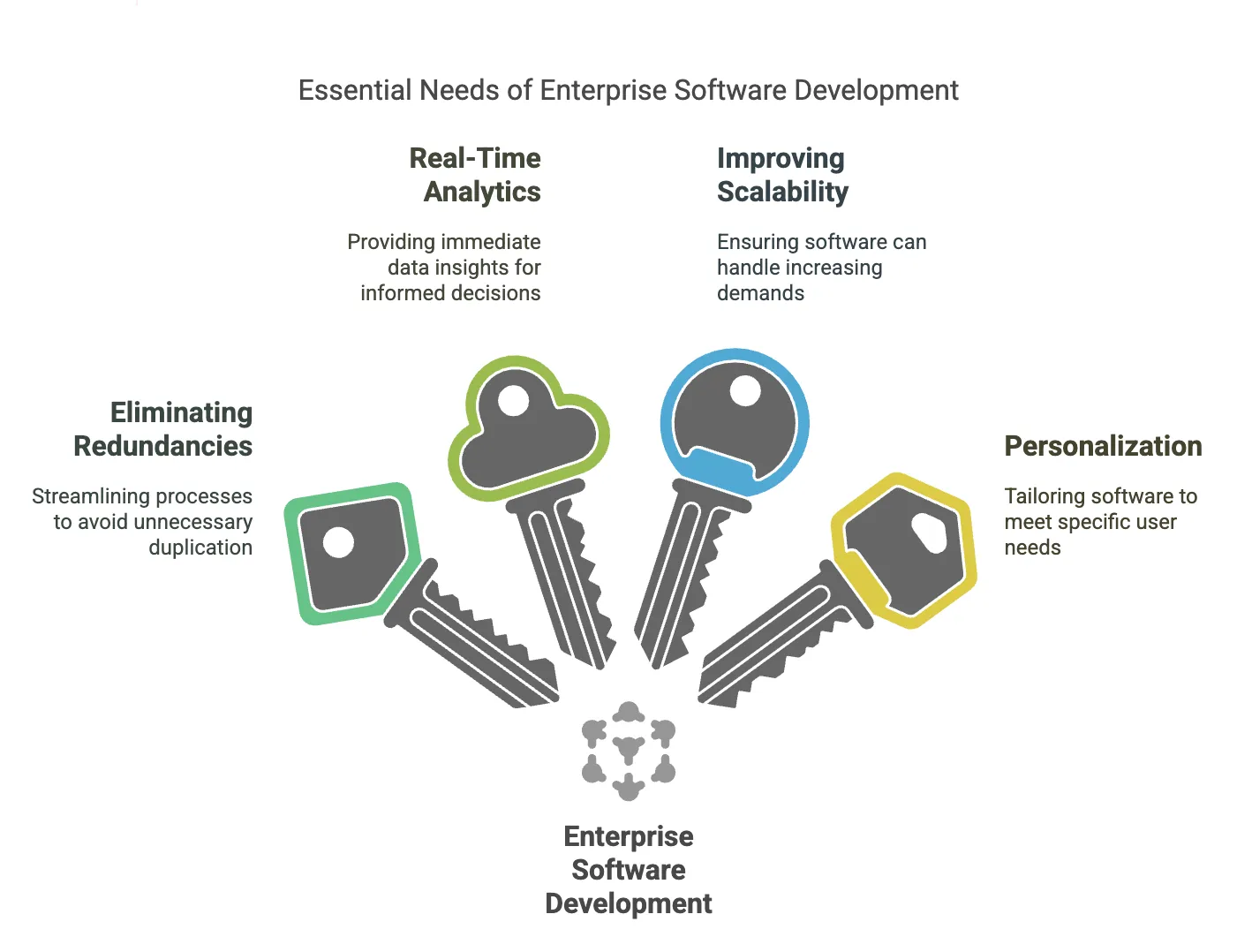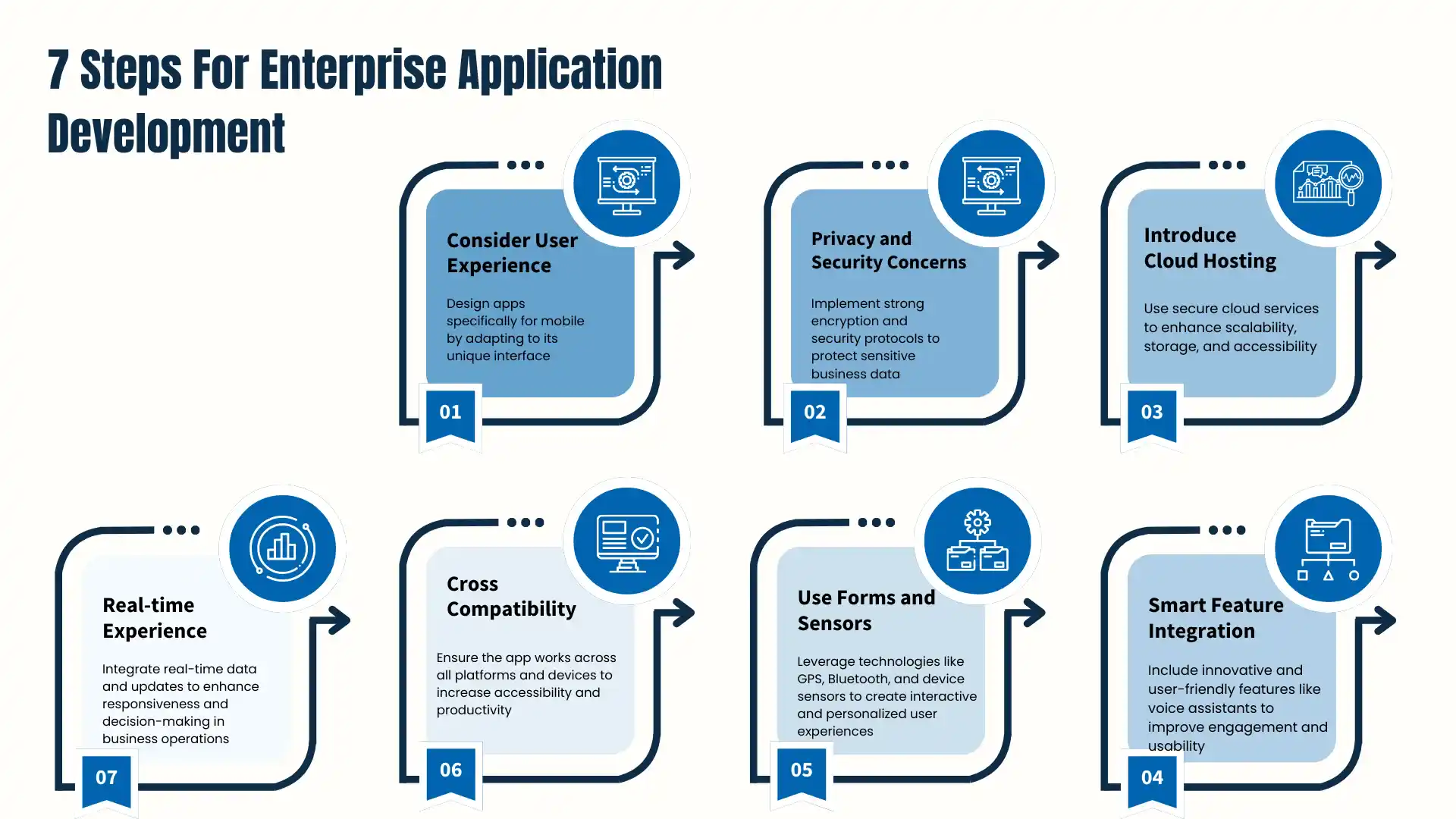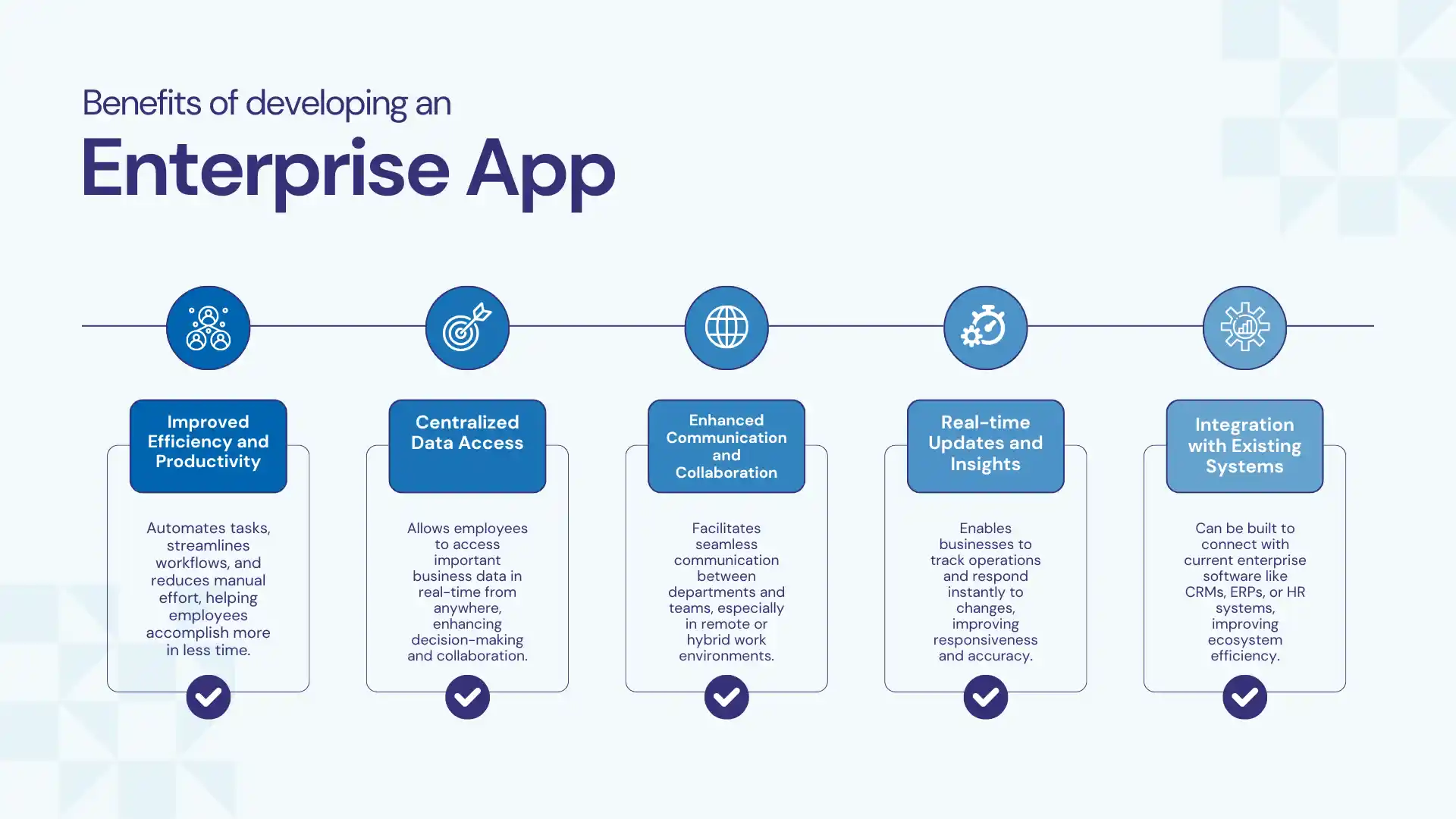Table of Contents
Global enterprise application market is estimated to be around $275.6 B.
And, growing by 20.9% CAGR.
Enterprise Application development is changing fast.
Today, IT teams work closely with business teams and outside partners to better meet user needs.
Cloud technology is helping make this easier.
In the past, making apps was slow and costly. Old technology made it harder to build them.
Around 76% of IT experts say it takes at least three months to create an app because they worry about security, systems, and making sure the app can grow.
Another problem is the shortage of good developers. 75% of organisations say they can’t find enough mobile app talent.
Only 36% manage to hire the right people within a year.
Because of this, old ways of building apps no longer work well. Enterprise app development services offer a faster, stronger way to create flexible apps for today’s digital world.
The Need For Enterprise Application Development

With time, digital transformation is rapidly changing the world.
And, Enterprise Application Development is developing fast due to technological changes.
With a proper Enterprise Application you can streamline operations and integrate departments. Also, it supports strategic decision-making.
If you want to have proper enterprise app development, then you need a plan that works for your business particularly
With that, you can do all these
- Eliminate Redundancies – You will avoid errors and duplicate efforts while handling lots of data.
- Provide Real Time Analytics – Get proper data on your reports and show it to the decision-makers easily.
- Improves Scalability – Address business growth without the need to train every team member, making it more efficient.
- Personalisation – Employees get flexibility to create their own pages and dashboards using different tools.
Real Time Benefits Of Enterprise Software Development
Developing a winning enterprise application is by far the most important in 2025.
It’ll provide you lot of competitive edge and you will be able to beat your competitors.
With a proper plan, Enterprise Application development can improve your team’s efficiency and you’ll be able to handle jobs efficiently.
You’ll be able to integrate data from different systems into one unified platforms.
And, overall you can improve all these
- Real Time Access – Get metrics whenever you need and provide better insights to stakeholders.
- Enhanced Collaboration – You can easily breakdown silos better different department in your organisation.
- Fully Customizable – No matter any industry, you can customize as per your need.
Traditional Application Development vs Enterprise Application Development
Let’s understand how each of them comes with their unique strengths and weaknesses.
Traditional Application Development
1. Scope And Scale
Traditional application development typically focuses on specific, contained problems or single-purpose solutions. These applications serve limited user bases, often within a single department or small organization.
2. Complexity And Architecture
Traditional applications often employ simpler architectures, sometimes built as monolithic systems where all components exist within a single codebase. These applications may use straightforward database designs and limited integration requirements.
3. Security And Compliance
Traditional applications implement basic security measures like user authentication and standard encryption, enterprise applications must navigate a labyrinth of security requirements
4. Development Timeline And Methodology
Traditional application projects often follow shorter development cycles, sometimes measured in weeks or a few months. Teams may use agile methodologies with relatively straightforward sprint planning.
5. Maintenance And Support
Traditional application maintenance typically involves periodic bug fixes, occasional feature updates, and standard technical support during business hours. Enterprise applications require dedicated support teams providing round-the-clock monitoring and assistance.
Enterprise Application Development
1. Scope And Scale
Enterprise application development addresses complex, organization-wide challenges that span multiple departments, business units, and sometimes entire corporate ecosystems.
2. Complexity And Architecture
Enterprise applications, however, demand sophisticated multi-tier architectures with distributed systems, microservices, and complex integration layers. They require robust middleware, message queuing systems, and service-oriented architectures to handle the interconnection of numerous systems, legacy platforms, and third-party services.
3. Security And Compliance
Enterprise applications incorporate multi layered security protocols including role based access control, single sign-on systems, advanced encryption standards, and comprehensive audit trails. Enterprise solutions must also comply with industry regulations such as GDPR, HIPAA, SOX, or PCI-DSS, requiring extensive documentation, regular security audits.
4. Development Timeline And Methodology
Enterprise application development extends across months or years, involving multiple phases of requirements gathering, stakeholder alignment, iterative development, and extensive testing.
5. Maintenance And Support
Whereas enterprise apps demand comprehensive change management processes, detailed documentation, regular patch cycles, and long-term vendor relationships. Enterprise systems also need clearly defined service level agreements, disaster recovery plans, and business continuity strategies to ensure organizational resilience.
Types Of Enterprise Applications You Can Build
Enterprise applications come in various forms, each designed to address specific organizational needs and business functions. Understanding these categories helps organizations identify the right solutions for their challenges and enables developers to specialize in particular domains.
1. Enterprise Resource Planning (ERP) Systems
ERP systems serve as the backbone of organizational operations, integrating core business processes into a unified platform. These comprehensive applications manage finance and accounting, human resources, procurement, inventory management, supply chain operations, and manufacturing processes.
ERP systems provide real-time visibility across the entire organization, enabling data-driven decision-making and eliminating information silos.
2. Customer Relationship Management (CRM) Systems
CRM applications focus on managing all aspects of customer interactions and relationships. These systems track customer data, sales pipelines, marketing campaigns, customer service interactions, and post-sale support activities. Modern CRM platforms incorporate analytics to predict customer behavior, automate marketing workflows, and provide sales teams with actionable insights.
3. Supply Chain Management (SCM) Applications
SCM systems orchestrate the complex flow of goods, information, and finances across the entire supply chain ecosystem. These applications manage supplier relationships, logistics coordination, warehouse operations, demand forecasting, and inventory optimization.
4. Business Intelligence and Analytics Platforms
BI applications transform raw organizational data into actionable insights through reporting, dashboards, data visualization, and advanced analytics. These systems aggregate information from multiple sources, enabling executives and managers to monitor key performance indicators, identify trends, and make informed strategic decisions.
5. Enterprise Content Management (ECM) Systems
ECM applications provide centralized repositories for managing documents, digital assets, records, and unstructured content throughout their lifecycle. These systems include document management, workflow automation, version control, collaboration features, and compliance tools for records retention.
Depending on your business’s needs you can build such enterprise applications that will be useful for you.
7 Steps For Enterprise Application Development

1. Consider User Experience:
In Enterprise Application Development, it’s important to know that mobile devices are very different from desktop computers.
Moving a desktop app straight to mobile is like trying to fit a square peg into a round hole.
Mobile devices have different screen sizes, shapes, processing power, and ways to interact.
To succeed, developers must see these differences and change their approach.
Simply copying a desktop app to mobile often causes problems and makes apps harder to use.
Instead, developers should create a smart plan for mobile apps.
They need to redesign the user experience to match the strengths and limits of mobile devices.
That’s why Enterprise Mobile App Development is a complicated process.
By understanding the process, they can unlock the full potential of Enterprise Application Development on mobile platforms.
2. Privacy and Security Concerns:
In Enterprise Application Development, security threats are always changing. Hackers are finding new ways to break into apps and steal data. Since many business owners now use enterprise apps, strong encryption is more important than ever.
Enterprise apps often hold large amounts of sensitive information. This makes it critical to have strong security protocols. Your app must be able to handle different risks and protect against hacking attempts.
Working with a trusted enterprise mobile app development company is key. By using their skills, you can build a secure and effective app that meets your business needs and protects your valuable data.
Investing in strong security now will help protect your business from future threats.
3. Introduce Cloud Hosting:
Cloud technology is a top choice for improving Enterprise Application Development. It provides strong data storage and ensures security. Businesses can only move to the cloud when their security is solid, which helps lower costs and build trust.
With security in place, many teams hire Xano developers to take advantage of Xano’s cloud-native features and backend power.
This allows businesses to keep data and apps in one place for safe access while using the cloud for other files. Cloud technology makes enterprise apps more flexible and scalable, improving operations and helping businesses stay competitive.
4. Smart Feature Integration:
Today, smart features like Siri and Cortana have changed how people use devices. These features are not just cool; they make digital communication easier. Businesses that want to succeed with mobile apps need to include simple and engaging features.
By focusing on innovation in Enterprise Application Development, businesses can make their apps connect better with users.
These apps should do more than just basic tasks—they should have features that make using the app fun and easy. Adding smart features can attract users and keep them coming back.
Enterprises should invest in apps with exciting features that keep users interested. By using smart features, businesses can stay ahead in the digital world and grow in a competitive market.
5. Use Forms and Sensors:
In Enterprise Application Development, technologies like Wi-Fi, Bluetooth, and GPS help apps work well together.
This makes it easier for users, like when a fitness app connects with a step tracker. As people use different features, data moves smoothly between platforms, improving the experience.
Adding important sensors makes apps more fun and interactive. For example, users can take photos and share them quickly or use location services for customised experiences.
These sensors make the app more engaging. Using these technologies is key to app development. It helps users enjoy the app and get the most out of it.
When developers combine these elements well, they can create apps that users love, leading to long-term satisfaction and loyalty.
6. Cross Compatibility:
In today’s fast-paced digital world, it’s important for apps to work well on different devices and platforms. Cross-platform customisation is key to making sure mobile apps meet the needs of all users, no matter what device they use.
This approach helps overcome limits and increases the app’s reach and usefulness. Without it, the app may not work well, leaving most users unable to use it.
For example, employees might not be able to access important tools because the app doesn’t work on their device or operating system.
This gap harms productivity and defeats the app’s purpose. So, adding cross-platform customisation is not just a good idea; it’s essential for getting users to adopt the app.
By using this strategy, companies can give their workers flexible tools that work across devices, boosting efficiency and innovation. A practical example of cross-platform compatibility is implementing mobile forms for business operations, which allows field workers to collect data, submit reports, and update information seamlessly whether they’re using iOS or Android devices.
7. Real-time Experience:
Mobile devices are everywhere and important for business.
Their constant connection and always-on features show how enterprise mobile apps can change how businesses work.
By using Enterprise Application Development methods, companies can use real-time updates to make their work better.
Adding real-time updates to business apps helps users react quickly to changes by using data from different sources.
Whether it’s improving delivery, managing stock, helping with customer service, or getting live traffic updates, the options are endless.
Integrating real-time updates into business applications enables users to swiftly adapt to dynamic circumstances by leveraging data from diverse sources. Whether optimizing logistics and inventory management, streamlining CRM processes, or staying informed with live traffic updates from third-party feeds, the possibilities are limitless.
Enterprise Application Development helps businesses build flexible solutions that keep up with changes. With real-time updates, these apps become useful tools that help businesses work faster and more successfully in a competitive market.

Conclusion
In the fast-changing world of Enterprise Application Development, businesses must focus on user experience, security, and innovation to succeed. Using mobile technology well means understanding both the challenges and opportunities.
By designing solutions specifically for mobile devices, businesses can get the most out of their apps. Cloud hosting makes apps more flexible and secure, while smart features and sensors keep users engaged.
Ensuring apps work on different devices helps them reach more people and be more useful. Real-time updates allow businesses to respond quickly to changes, making them more adaptable.
By using these smart strategies, businesses can stay ahead and improve innovation, efficiency, and success in today’s digital world.
FAQs
What is an enterprise application developer?
An enterprise application developer designs, builds, and maintains applications for specific business functions. They work with others to make sure the application meets the company’s needs.
What is enterprise application development?
Enterprise application development is making custom software for big organizations. This software helps them automate tasks, streamline work, and improve productivity. It lets developers make the most of current tech and adapt to new business needs.
What are four major types of enterprise applications?
There are four main types of enterprise applications. These are enterprise resource planning systems, supply chain management systems, customer relationship management systems, and human resource management systems. These are also called business apps.
How long does it take to develop an enterprise application?
It might take three to nine months to build an enterprise application. The time depends on how complex the app is. It also depends on how experienced the developers are.
What are the challenges of enterprise application development?
There are several challenges in building enterprise applications. Some common ones include changing business needs and security concerns. It’s also challenging to handle and store data well and to create a good user experience.
What Are The Key Characteristics Of Enterprise Applications?
Enterprise applications are characterized by their ability to scale massively, supporting thousands of concurrent users with high availability (99.9%+ uptime) and robust multi-layered security frameworks including role-based access controls and comprehensive audit trails. They feature extensive integration capabilities to connect with other systems, powerful customization options to adapt to unique business processes, and sophisticated data management for handling vast datasets across complex organizational hierarchies.